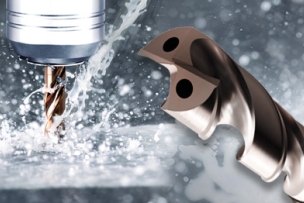More than a century of expertise in cutting tool manufacturing, combined with powerful R&D resources, place Guhring at the forefront of technical innovations in cutting tools. Guhring meets specific customer requirements—from process proposal to production application—with quality cutting tool solutions. With approximately 8,000 employees across the globe, and more than 70 production locations in 48 countries, Guhring is a powerful metalworking resource.
Think of Guhring’s RT 100 flat-bottom drill as a triple threat: It can handle piloting, drilling or finishing.
Because of that, the RT 100 FB can eliminate as many as three tool changes and setups that would interrupt work for machinists relying on pointed drills and other tools to cut holes into oblique or curved surfaces.
For small maintenance and repair shops, which are more likely than large production facilities to face such tasks, the drills “solve a lot of cycle-time and tool-wear issues because you’re able to complete the hole much faster,” says Paul Larson, Guhring’s product manager for drills and thread mills.
Traditional drills, with a point angle of 118 degrees to 135 degrees, aren’t suited for creating holes at an angle since they’re easily deflected from the sloped surface.
Without a flat-bottom drill, a machinist working at that angle would typically begin with an end mill to create a flat surface to which a pilot drill and a spot drill could be applied, depending on the job. The flat surface is created by plunging with the end mill or utilizing a helical toolpath with the end mill.
Larson says those require time for both machine setup and toolpath determination.
“When all of that’s involved, you’ve got cycle time,” he adds. “The RT 100 FB solves lots of cycle-time and tool-wear issues because you’re able to complete the hole much faster.”
Both tool wear and cycle time are increasingly critical issues for machine shops and manufacturing facilities grappling with high inflation, a shortage of workers and lingering supply chain disruption.
For job shops and businesses with very small runs in particular, “it becomes cost-prohibitive to have to buy three different tools to complete one hole that’s on an angle, an arc or in the bottom of a slot,” Larson says. “With a flat-bottom drill, you can utilize one tool to accomplish all of that.”

.jpg?itok=Eh22SKJi)






Talk to Us!
Leave a reply
Your email address will not be published. Required fields are marked *